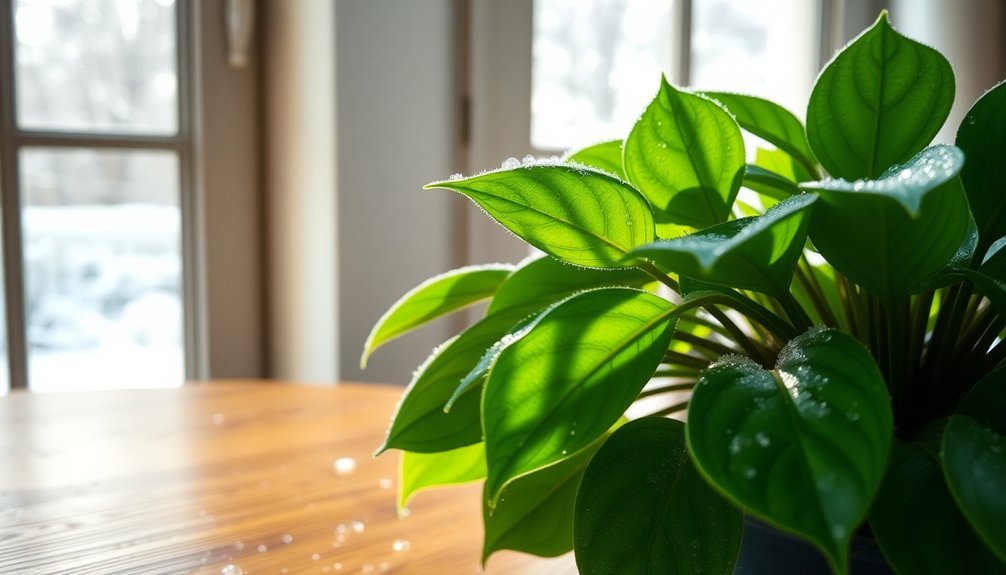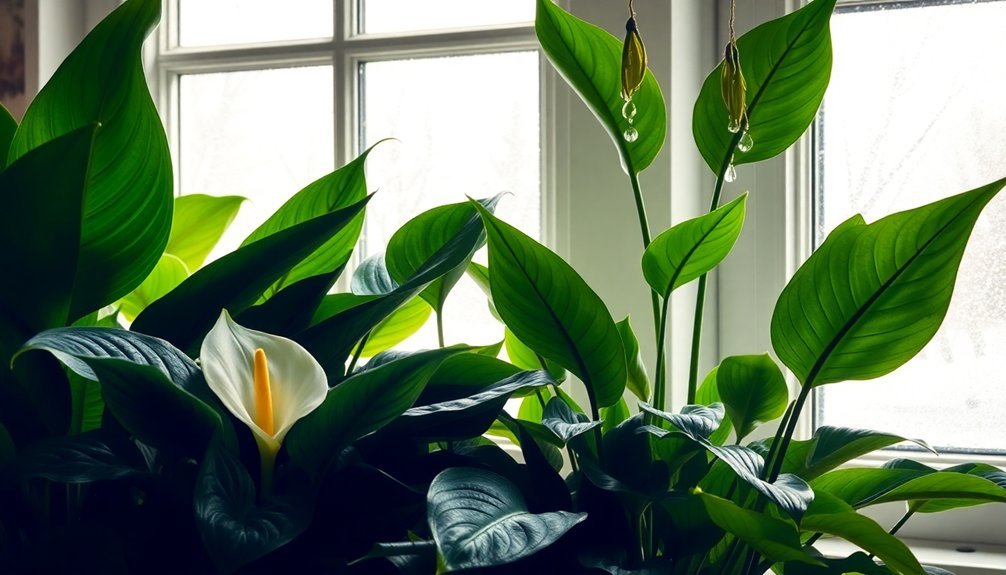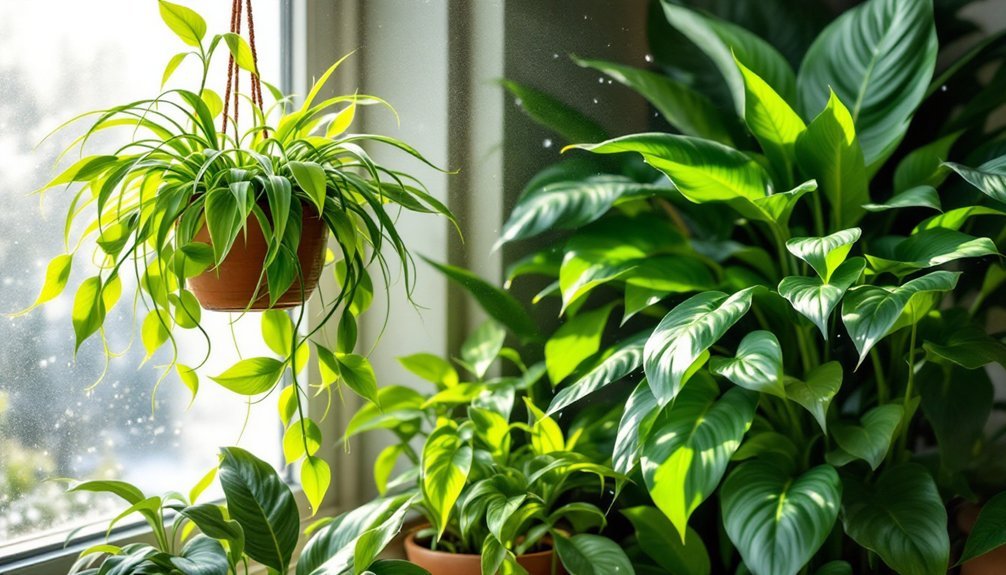Your indoor plants will still clean the air during winter dormancy, but they're about 75% less effective due to reduced metabolic activity and photosynthesis. You'll notice the biggest drop in air-purifying power from popular varieties like spider plants and peace lilies. To maximize their filtering capabilities, you'll need to provide proper lighting, maintain humidity, and adjust your care routine. Understanding how to support your plants during winter months can help restore their full air-cleaning potential.
Understanding Plant Air Purification During Winter Rest

Although houseplants continue to purify air during winter, their effectiveness decreases considerably as they enter a period of dormancy.
You'll notice this reduction in air purification as your plants slow their metabolic activity during the colder months.
Even popular air-cleaning varieties like spider plants and peace lilies become less efficient when light levels and humidity drop.
While they're still converting carbon dioxide to oxygen, they're doing so at a much slower rate.
To maximize your plants' air-purifying abilities during winter dormancy, you'll need to maintain proper care routines.
However, it's important to understand that even well-maintained indoor plants can't replace adequate ventilation during winter.
Your best approach is to combine plant care with good airflow to maintain healthy indoor air quality throughout the dormant season.
The Science Behind Dormant Plant Filtering
While plants enter their winter rest period, the science behind their air-filtering capabilities reveals fascinating changes at the cellular level. You'll notice your indoor plants become less effective at filtering pollutants as their metabolic processes slow down. During dormancy, photosynthesis decreases due to reduced light exposure, affecting their ability to process air contaminants.
| Process | Active vs. Dormant |
|---|---|
| Photosynthesis | 75% reduction |
| Pollutant absorption | 60% slower |
| Air filtering | Limited capacity |
| Light needs | Decreased intake |
| Humidity response | Minimal activity |
While your dormant plants still contribute to air purification, they're operating at a fraction of their usual capacity. To maximize their filtering abilities during winter, you'll want to maintain proper light conditions and humidity levels. This helps support basic maintenance functions, even though plants won't match their peak filtering performance until spring.
Top Air-Cleaning Plants for Winter Months

You'll find several powerhouse plants that excel at filtering indoor air during winter, with the Snake Plant and Spider Plant leading the pack for their reliable performance even during dormancy.
The Peace Lily stands out as a top choice for tackling formaldehyde and benzene, while the Boston Fern adds valuable humidity to dry winter air.
For spaces with lower light conditions, English Ivy proves especially effective at reducing airborne mold and other particles, making it an ideal winter air purifier.
Indoor Plant Filtering Power
Nature's air purifiers remain hard at work even during the coldest months of the year. While indoor plants enter winter dormancy, they'll continue their essential role in air purification, removing common pollutants through their leaves and roots.
You'll find that even in low-light conditions, resilient species like Spider Plants and Peace Lilies effectively cleanse your indoor air quality.
To maximize your plants' air-cleaning potential, you'll want to group plants together, creating a beneficial microenvironment that enhances their filtering capabilities.
Studies show that certain tropical plants, like the Boston Fern and Rubber Plant, can eliminate up to 87% of air toxins within just 24 hours.
Even when they're growing slowly, these natural air purifiers don't stop working to filter harmful particles from your indoor environment.
Best Low-Light Air Purifiers
Several top-performing air-purifying plants stand ready to combat winter's indoor pollutants, even in the dimmest corners of your home. The ZZ Plant and Peace Lily thrive in low-light conditions, making them perfect houseplants for the darker winter months while they continuously clean your air.
To maximize indoor air quality, you'll want to combine different species. The Snake Plant and Pothos efficiently remove toxins like formaldehyde and benzene, while the Boston Fern adds much-needed humidity to dry winter air.
Though many of these plants originate from tropical regions, they've adapted well to indoor environments.
Keep your plants healthy by watching for signs of pests and maintaining consistent care routines. Even during winter dormancy, these air-purifying champions will continue filtering harmful VOCs, with some varieties removing up to 87% of airborne toxins daily.
Optimizing Indoor Air Quality With Sleeping Plants
While winter sends most plants into dormancy, their ability to purify indoor air remains remarkably active. You'll find that plants need minimal care to maintain their air-purifying capabilities during this season. Even when the soil is dry and growth slows, they continue filtering indoor pollutants like formaldehyde and benzene.
To maximize how plants indoors clean your air, focus on a few key practices. Start by regularly cleaning their leaves to enhance light absorption and photosynthesis.
Consider grouping plants together, as this creates a microclimate with high humidity that boosts their effectiveness. Peace lilies and snake plants are particularly efficient at maintaining air quality during winter months.
Winter Plant Placement for Maximum Air Benefits

Strategic plant placement during winter months can dramatically boost their air-purifying performance in your home.
Even though plants reduce growth activity during winter, you'll maximize their benefits by positioning air-purifying plants in well-lit areas, particularly near south- or west-facing windows.
To enhance indoor air quality, group your plants together to create a beneficial micro-climate that maintains ideal humidity levels.
Don't forget regular dust removal from leaves, as this simple winter care practice improves photosynthesis efficiency.
Place moisture-loving varieties like peace lilies and spider plants in clusters to combat dry winter air while continuing their air-cleaning functions.
Though your plants may be dormant, they're still working to purify your air – you'll just need to help them perform at their best through thoughtful plant placement and maintenance.
Supporting Plant Performance in Low-Light Seasons
Position your plants near south-facing windows to capture maximum natural light, and you'll help maintain their air-purifying abilities during winter's shorter days.
You can supplement natural light with grow lights adjusted to provide 12-14 hours of consistent illumination, ensuring your plants receive enough energy for photosynthesis and toxin removal.
Watch your plants' growth patterns and leaf positions to gauge if they're getting sufficient light, and relocate them as needed to optimize their air-cleaning performance during the low-light season.
Maximize Natural Light Exposure
Since winter brings shorter days and weaker sunlight, your indoor plants need assistance maximizing their light exposure to maintain their air-cleaning abilities.
Even during dormancy, insufficient light can impair their ability to photosynthesize effectively. You'll want to place your plants near south- or west-facing windows to capture the most winter sunlight throughout the day.
To optimize light penetration, keep your windows clean and dust off plant leaves regularly.
Consider each individual plant's light needs, as some species require more illumination than others to maintain healthy growth. If natural light isn't enough, you can supplement with grow lights to guarantee your plants receive adequate exposure.
These simple adjustments will help your indoor plants thrive despite the challenging winter conditions.
Adjust Artificial Light Settings
Enhancing your indoor plants' air-purifying abilities during winter requires thoughtful artificial lighting adjustments. To combat reduced light conditions and prevent dormancy, you'll need to optimize your grow lights' settings to maintain active photosynthesis and consistent indoor air quality.
Position full-spectrum LED grow lights 12-24 inches above your plants to provide adequate intensity without causing leaf damage. You'll want to keep these lights on for 12-16 hours daily, simulating longer daylight hours to encourage continuous air-purifying performance.
Remember that different plant species have varying light requirements, so adjust your artificial light settings accordingly. By monitoring and fine-tuning light duration and placement throughout the winter months, you'll help your plants maintain their air-filtering capabilities when natural light is scarce.
Monitor Growth Response Patterns
To maintain your plants' air-purifying abilities during winter, monitoring their growth response patterns becomes essential.
You'll need to regularly inspect your plants for signs of stress, including yellowing leaves or slowed growth, which can indicate reduced photosynthesis due to limited light exposure.
Keep your plants happy by adjusting their care based on their individual responses.
Monitor growth and adapt your watering schedule according to their winter needs.
Pay attention to humidity levels, as proper moisture can help compensate for reduced metabolic activity.
If you notice your plants struggling with natural light source limitations, consider using grow lights to boost their air-cleaning performance.
While winter dormancy naturally affects air quality impact, staying attentive to these growth patterns helps guarantee your plants continue filtering toxins effectively, even during low-light seasons.
Frequently Asked Questions
What Plant Removes 78% of Airborne Mold?
You'll want to get a Peace Lily (Spathiphyllum) for your home, as it removes 78% of airborne mold. It's highly effective at purifying air and filtering out harmful pollutants like formaldehyde and benzene.
What Do Dormant Plants Do in the Winter?
During winter, you'll notice your dormant plants conserve energy by slowing metabolism, shedding leaves, and focusing on root growth. They'll reduce water intake and store nutrients while waiting for spring's warmer temperatures and longer days.
Can Plants Really Purify Air?
Yes, your indoor plants can purify air by absorbing toxins like formaldehyde and benzene through their leaves and roots. While they're not as effective as air filters, they'll still help improve your air quality.
Can Plants Remove Mold From the Air?
Yes, you'll find that certain houseplants can actively remove mold spores from your indoor air. Plants like peace lilies and spider plants trap airborne particles and can reduce mold levels by up to 87%.
In Summary
Even during winter dormancy, your plants continue filtering air at a reduced rate. While they won't clean as effectively as during growing seasons, you'll still benefit from keeping them indoors. Place your dormant plants in bright, indirect light and maintain proper humidity to maximize their air-purifying potential. Don't give up on your green air cleaners – they're working for you year-round, just at a slower pace.





Leave a Reply